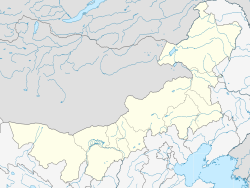Top Qs
Timeline
Chat
Perspective
Hulunbuir
Prefecture-level city in Inner Mongolia, China From Wikipedia, the free encyclopedia
Remove ads
Hulunbuir or Hulun Buir[b] is a prefecture-level city in northeastern Inner Mongolia, China. Its administrative center is located at Hailar District, its largest urban area. Major scenic features are the high steppes of the Hulun Buir grasslands, the Hulun and Buir lakes (the latter partially in Mongolia), and the Khingan range. Hulun Buir borders Russia to the north and west, Mongolia to the south and west, Heilongjiang province to the east and Hinggan League to the direct south. Hulunbuir is a linguistically diverse area: next to Mandarin Chinese, Mongolian dialects such as Khorchin and Buryat, the Mongolic language Daur, and some Tungusic languages, including Oroqen and Solon, are spoken there.
Remove ads
History
Summarize
Perspective
During the Qing dynasty (1644–1912), Hulunbuir was part of Heilongjiang province. The 1858 Treaty of Aigun established today's approximate Sino-Russian border, at a great loss to Heilongjiang's territory. In 1901, the Chinese Eastern Railway linked Hulunbuir to the rest of northeast China and to Russian Far East. From 1912 to 1949, during the Republic of China (ROC) period, Hulunbuir was part of Xing'an and Heilongjiang provinces. In winter 1912, the Barga Mongol people of Hulunbuir expelled the Chinese troops and administration and proclaimed the independence of Barga (Hulunbuir); afterwards they declared allegiance to the Bogdo Khan of Mongolia; an agreement between the Russian Empire and the ROC on November 6/October 24, 1915 designated Hulunbuir a "special" region under direct subordination to the Central Government of China, but in practice Russia had partial control over day-to-day administration and economy.[3][4] In 1929, the Soviet Union broke this agreement and invaded Hulunbuir.[5]: 406 After the Japanese invasion of China, Hulunbuir became part of the Japanese puppet state Manchukuo, which was not recognized by the Chinese. In the Chinese Civil War, the Chinese Communist Party gained the support of Inner Mongol leaders like Ulanhu by promising the irredentist expansion of Inner Mongolia into areas that had majorities of Han and Manchu peoples.[6]: 90–91
After the Chinese Communist Revolution, Hulunbuir was annexed into Inner Mongolia, but the region kept economic ties to the rest of the northeast via the Chinese Eastern Railway.[7] During the Cultural Revolution, the parts of historical Manchuria inside Inner Mongolia were briefly restored to their original provinces; Hulunbuir was given back to Heilongjiang from 1969 to 1979.[7] Until October 10, 2001, Hulunbuir was administered as a League. The area is 263,953 km2 (101,913 sq mi) and had a population of 2.710 million in 2004, while the gross domestic product was RMB 21.326 billion. The jurisdiction area of the city is larger than all but 8 Chinese province-level divisions (and 42 U.S. states), although the actual urban agglomeration is just a very small part of the region, and the average population density of the area is very low.
Remove ads
Names


The city was once a league (盟) of Inner Mongolia, until 10 October 2001. During the Qing dynasty, it was known in Mandarin as Hūlúnbùyǔ'ěr (simplified Chinese: 呼伦布雨尔; traditional Chinese: 呼倫布雨爾).
Administrative subdivisions
Summarize
Perspective
Hulunbuir is divided into 13 different county-level jurisdictions: one district, five county-level cities, four banners and three autonomous banners.
Remove ads
Geography and climate
Summarize
Perspective


Hulunbuir itself (Hailar) has an extreme humid continental climate (Köppen Dwb, Trewartha Dcbd/Dcbc). Winters are long, very dry and severe, due to the semi−permanent Siberian High, while summers are short, though very warm, and rather wet, due to the East Asian monsoon. At Hailar, the monthly 24-hour average temperature ranges from −25.0 °C (−13.0 °F) in January to 20.9 °C (70 °F) in July, while the annual mean is −0.2 °C (31.6 °F), relatively cold. With at least 58% of possible sunshine in all months and an annual total greater than 2,591.1 hours, sunny weather dominates year-round. Approximately 51% of the annual rainfall occurs in July and August.
Remove ads
Demographics

Transport
Airports include:
See also
Notes
- Mongolian: ᠬᠥᠯᠥᠨ ᠪᠤᠶᠢᠷ ᠬᠣᠲᠠ
- Mongolian:
 , Kölün buyir, Mongolian Cyrillic: Хөлөнбуйр, Khölönbuir; Chinese: 呼伦贝尔, Hūlúnbèi'ěr; Russian: Хулунбуир, Khulunbuir
, Kölün buyir, Mongolian Cyrillic: Хөлөнбуйр, Khölönbuir; Chinese: 呼伦贝尔, Hūlúnbèi'ěr; Russian: Хулунбуир, Khulunbuir
References
Further reading
External links
Wikiwand - on
Seamless Wikipedia browsing. On steroids.
Remove ads




